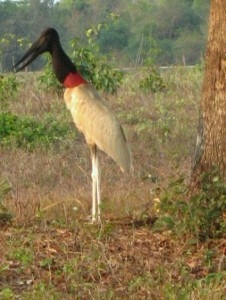
Photo © Michael Sommers.
I’ve never been into birds and never understood what the big deal was until I went to the Pantanal. That’s because in the Pantanal the birds are BIG – some of them even bigger than me! They are also colorful – and absolutely everywhere.
Among birders, the Pantanal is known as Grand Bird Central. More than 600 species make their home amidst this unique biome’s marshes and savannas. The list includes various types of parrots, egrets, jays, cormorants, raptors, seriemas, plovers, sandpipers, skimmers, terns, doves, cuckoos, owls, nightjars, potoos, hummingbirds, trogons, ovenbirds, tanagers, cardinals, finches, blackbirds, orioles, spoonbills, woodpeckers, tyrants, eagles, ibis, macaws, ducks, hawks, and toucans. And that’s just for starters. And in English. When you’re actually in the Pantanal, you’ll hear these birds called by either their Portuguese or indigenous names – which are far more poetic and/or sonorous (although the mixture of languages makes keeping track of who’s who quite a feat).
Visually, these feathered creatures are fascinating to observe: whether they’re standing in a marsh, solitary and elegant; screeching, en masse, in a tree; or taking sudden flight in a deafening rustle of feathers.
However, ogling these birds is just one part of the equation. There is also listening to them.
Every morning in the Pantanal, my sister, Annie (who took the above photo), and I were awakened at 4:30 a.m. by a crazy symphony of sounds that I will call bird cries, but in whose ear-splitting cacophony I could hear whispers, pops, rattles, honks, snare drums, hysterical shrieks, and so much more. We kicked ourselves repeatedly for having been too lazy to bring a small recorder to tape the jungle adventure, B-movie soundtrack.
* * *
Among the most amazing and memorable birds we encountered were three that are most famously associated with the Pantanal:
Jabiru (Jabiru mycteria) a.k.a. jaburu, tuiuiú, and tuim de papo vermelho. This stork is the tallest flying bird in Latin America. Indeed, getting close to one is a daunting experience that resembles approaching an aristocratic and slightly sinister gentleman (with great posture) – this is because a full-grown jabiru stands at a height of 1.5 meters (5 feet). Its dusky black head, scarlet neckband and white body are graphically stunning and explain why the bird has been adopted as Mato Grosso’s state mascot (even public telephones are modeled after jabirus). Although we ran into many of these storks on the ground, we also glimpsed one in its enormous nest (the size of a rowboat), feeding its oversized babies.
Toco toucan (Ramphastos toco) a.k.a. toucano açu. The largest of all toucans, the toco is striking due to its jet black and ivory white plumage and its eyes ringed by a psychedelically bright ring of blue and orange skin (for a close-up view, check out the cover of Moon Brazil). But what really grabs you is its Technicolor bill in sunset hues of yellow-red-orange. Proportionally, the toco boasts the largest bill in the bird kingdom (it comprises 30-50 percent of the bird’s size), a feature that that gives it the surreal charm of a fabulous cartoon character come to life. French naturalist, Buffon, referred to the bill as a “monstrous appendage” while Charles Darwin imagined it to be a “sexual ornament” (in fact, it functions as a thermal radiators, regulating heat distribution). Hollow inside, the bill actually weighs very little. Although we didn’t see any toucans up close, we were shocked a couple of times to see them flying above us, in slow motion, as we drove down the Transpantaneira highway.
Hyacinth macaw (Anodorhynchus hyacinthinus) a.k.a. arara azul. Not only the world’s largest macaw, the hyacinth macaw is also the world’s largest flying parrot. Sadly, it is also one of the world’s most endangered species. It’s not hard to understand why poachers, wild animal traffickers, and moguls with their own private menageries would risk fines and jail time to get their hands on this feathered creature (whose black market rate is around US$12,000): the large birds (adults measure up to 3 feet) appear to have been dipped in a rich indigo blue that contrasts with the splashes of banana yellow that ring their eyes and outline their beaks.
Happily, most owners of the Pantanal’s fazenda-lodges are serious about protecting these birds (as is the highly successful Hyacinth Macaw Project) and in recent years, the population has come back from the brink; there are now more than 5,000 hyacinth macaws living in the Pantanal (up from 1,500 in the ‘80s).
Many people don’t get to see hyacinth macaws. Annie and I were lucky; at the Jaguar Ecological Reserve where we stayed, there was a gigantic species of local palm amidst whose foliage groups of macaws clustered in the late afternoon to snack upon the seeds contained in the fruit. The ruckus they made while feeding was deafening and ranged from low grumbles, as they chatted amongst themselves, to booming squawks that reverberated through the sky. The size and blueness of these birds made them seem much more mythical than real; the same sensation we experienced when we laid eyes upon the jabirus and toucans.
* * *
Although there’s no end to all the birds that will walk or fly into your line of vision in the Pantanal, serious and amateur birders alike should take note that there exists a <strong>Pantanal Bird Club. Operated by local biologists and ornithologists (who speak English), the club offers guided bird tours of the Pantanal to small groups who won’t fail to be impressed by the array of feathered attractions on display.